INFINITI Q60 COUPE 2018 Owner's Manual
Manufacturer: INFINITI, Model Year: 2018, Model line: Q60 COUPE, Model: INFINITI Q60 COUPE 2018Pages: 466, PDF Size: 2.48 MB
Page 321 of 466

5-142Starting and driving
JVS0345X
Key LOCK warning
The information is displayed and a buzzer
sounded to remind the driver to place the
ignition switch in the OFF position to avoid a
discharged battery.
The message can be cleared by placing the
ignition switch in the OFF position (or
restarting the engine) or pushing the
orswitch on the steering wheel.
JVS0346X
System fault
This message is displayed when the Idling
Stop System is malfunctioning.
It is recommended you have the system
checked by an INFINITI retailer.
JVS0269X
IDLING STOP OFF SWITCH
The system can be temporarily deactivated
by pushing the Idling Stop OFF switch.
Pushing the switch again or restarting the
engine by using the ignition switch will
reactivate the Idling Stop System.
.When the Idling Stop System is deacti-
vated while the engine is running, the
engine is prevented from automatically
stopping.
.When the Idling Stop System is deacti-
vated after the engine has been auto-
matically stopped by the Idling Stop
System, the engine will immediately
restart if suitable conditions are present.
The engine will then be prevented from
Page 322 of 466

automatically stopping during the same
journey.
.Whenever the Idling Stop System is
deactivated the indicator light
on the
Idling Stop OFF switch illuminates. In
this condition the Idling Stop System
cannot prevent unnecessary fuel con-
sumption, exhaust emissions, or noise
during your journey.
.If the Idling Stop System is malfunction-
ing, the indicator light
on the Idling
Stop OFF switch illuminates.
NOTE:
The Idling Stop System ON or OFF message
is displayed for a few seconds in the vehicle
information display when the Idling Stop
OFF switch is pushed. See “Idling Stop
System ON or OFF” (P.5-141).
FREEING A FROZEN DOOR LOCK
To prevent a door lock from freezing, apply
deicer through the key hole. If the lock
becomes frozen, heat the key before insert-
ing it into the key hole or use the Intelligent
Key system.
ANTIFREEZE
In the winter when it is anticipated that the
outside temperature will drop below 32°F
(0°C), check antifreeze to assure proper
winter protection. For additional informa-
tion, see “Engine cooling system (for
VR30DDTT engine models)” (P.8-6), “En-
gine cooling system (for 2.0L turbo gasoline
engine models)” (P.8-8) or “Intercooler cool-
ing system (for VR30DDTT engine models)”
(P.8-9).
BATTERY
If the battery is not fully charged during
extremely cold weather conditions, the bat-
tery fluid may freeze and damage the
battery. To maintain maximum efficiency,
the battery should be checked regularly. For
additional information, see “Battery” (P.8-
16).
DRAINING OF COOLANT WATER
If the vehicle is to be left outside without
antifreeze, drain the cooling system, includ-
ing the engine block. Refill before operating
the vehicle. For details, see “Engine cooling
system (for VR30DDTT engine models)”
(P.8-6) or “Engine cooling system (for 2.0L
turbo gasoline engine models)” (P.8-8).
TIRE EQUIPMENT
SUMMER tires have a tread designed to
provide superior performance on dry pave-
ment. However, the performance of these
tires will be substantially reduced in snowy
and icy conditions. If you operate your
vehicle on snowy or icy roads, INFINITI
recommends the use of MUD & SNOW or
ALL SEASON tires on all four wheels. It is
recommended you consult an INFINITI re-
tailer for the tire type, size, speed rating and
availability information.
For additional traction on icy roads, studded
tires may be used. However, some U.S.
states and Canadian provinces prohibit their
use. Check local, state and provincial laws
before installing studded tires.
Skid and traction capabilities of studded
snow tires, on wet or dry surfaces, may be
poorer than that of non-studded snow tires.
Tire chains may be used. For details, see
“Tire chains” (P.8-40) of this manual.
Starting and driving5-143
COLD WEATHER DRIVING
Page 323 of 466
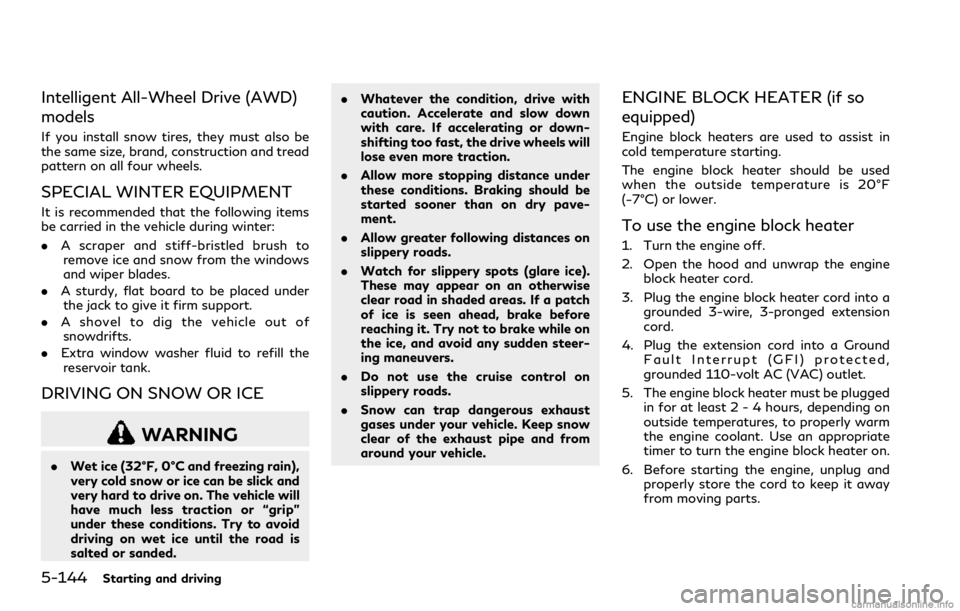
5-144Starting and driving
Intelligent All-Wheel Drive (AWD)
models
If you install snow tires, they must also be
the same size, brand, construction and tread
pattern on all four wheels.
SPECIAL WINTER EQUIPMENT
It is recommended that the following items
be carried in the vehicle during winter:
.A scraper and stiff-bristled brush to
remove ice and snow from the windows
and wiper blades.
.A sturdy, flat board to be placed under
the jack to give it firm support.
.A shovel to dig the vehicle out of
snowdrifts.
.Extra window washer fluid to refill the
reservoir tank.
DRIVING ON SNOW OR ICE
WARNING
.Wet ice (32°F, 0°C and freezing rain),
very cold snow or ice can be slick and
very hard to drive on. The vehicle will
have much less traction or “grip”
under these conditions. Try to avoid
driving on wet ice until the road is
salted or sanded..Whatever the condition, drive with
caution. Accelerate and slow down
with care. If accelerating or down-
shifting too fast, the drive wheels will
lose even more traction.
.Allow more stopping distance under
these conditions. Braking should be
started sooner than on dry pave-
ment.
.Allow greater following distances on
slippery roads.
.Watch for slippery spots (glare ice).
These may appear on an otherwise
clear road in shaded areas. If a patch
of ice is seen ahead, brake before
reaching it. Try not to brake while on
the ice, and avoid any sudden steer-
ing maneuvers.
.Do not use the cruise control on
slippery roads.
.Snow can trap dangerous exhaust
gases under your vehicle. Keep snow
clear of the exhaust pipe and from
around your vehicle.
ENGINE BLOCK HEATER (if so
equipped)
Engine block heaters are used to assist in
cold temperature starting.
The engine block heater should be used
when the outside temperature is 20°F
(−7°C) or lower.
To use the engine block heater
1. Turn the engine off.
2. Open the hood and unwrap the engine
block heater cord.
3. Plug the engine block heater cord into a
grounded 3-wire, 3-pronged extension
cord.
4. Plug the extension cord into a Ground
Fault Interrupt (GFI) protected,
grounded 110-volt AC (VAC) outlet.
5. The engine block heater must be plugged
in for at least 2 - 4 hours, depending on
outside temperatures, to properly warm
the engine coolant. Use an appropriate
timer to turn the engine block heater on.
6. Before starting the engine, unplug and
properly store the cord to keep it away
from moving parts.
Page 324 of 466
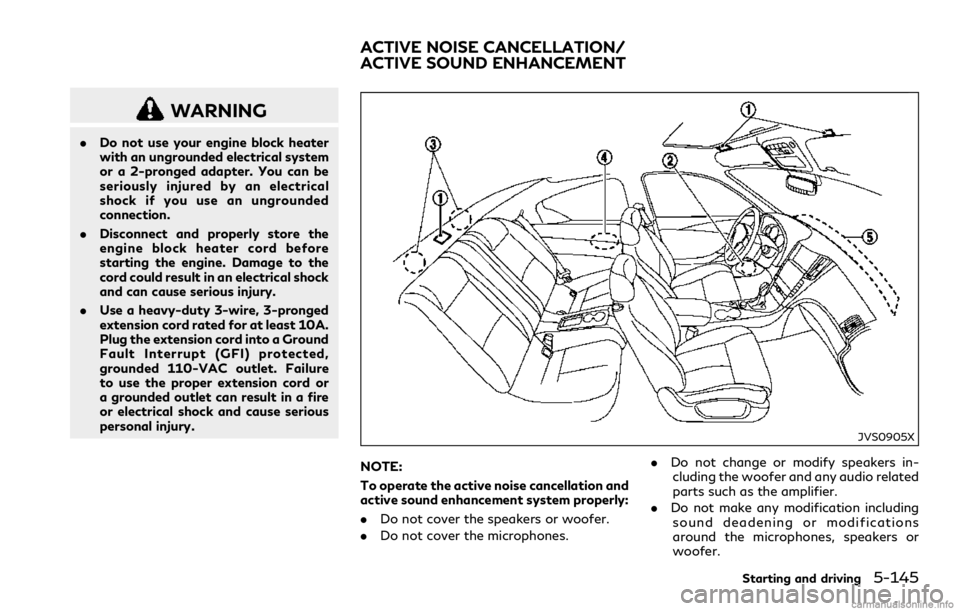
WARNING
.Do not use your engine block heater
with an ungrounded electrical system
or a 2-pronged adapter. You can be
seriously injured by an electrical
shock if you use an ungrounded
connection.
.Disconnect and properly store the
engine block heater cord before
starting the engine. Damage to the
cord could result in an electrical shock
and can cause serious injury.
.Use a heavy-duty 3-wire, 3-pronged
extension cord rated for at least 10A.
Plug the extension cord into a Ground
Fault Interrupt (GFI) protected,
grounded 110-VAC outlet. Failure
to use the proper extension cord or
a grounded outlet can result in a fire
or electrical shock and cause serious
personal injury.
JVS0905X
NOTE:
To operate the active noise cancellation and
active sound enhancement system properly:
.Do not cover the speakers or woofer.
.Do not cover the microphones..Do not change or modify speakers in-
cluding the woofer and any audio related
parts such as the amplifier.
.Do not make any modification including
sound deadening or modifications
around the microphones, speakers or
woofer.
Starting and driving5-145
ACTIVE NOISE CANCELLATION/
ACTIVE SOUND ENHANCEMENT
Page 325 of 466

5-146Starting and driving
ACTIVE NOISE CANCELLATION
The active noise cancellation uses micro-
phoneslocated inside the vehicle to detect
engine booming noises. The system then
automatically produces a muted engine
booming noise through the speakers
,(if so equipped),(if so equipped) and
wooferto reduce engine booming noise.
If the microphone
or the area around it is
tapped, abnormal noise may be output from
the speaker.
ACTIVE SOUND ENHANCEMENT
The active sound enhancement generates
sounds according to engine speed and
driving modes through the speakers
and(if so equipped) to enhance the quality of
the engine sound.
Page 326 of 466

6 In case of emergency
Hazard warning flasher switch...................................... 6-2
Roadside assistance program......................................... 6-2
Emergency engine shut off............................................. 6-3
Flat tire ................................................................................. 6-3
Tire Pressure Monitoring System (TPMS) ............ 6-3
Run-flat tires.................................................................. 6-4
Changing a flat tire...................................................... 6-5
Repairing a flat tire (for models with emergency
tire puncture repair kit)............................................... 6-9Jump starting ................................................................... 6-15
Main battery (for all models) ................................ 6-17
Auxiliary battery (for 2.0L turbo gasoline
engine models)........................................................... 6-19
Push starting .................................................................... 6-21
If your vehicle overheats............................................... 6-21
Towing your vehicle........................................................ 6-22
Towing recommended by INFINITI..................... 6-23
Vehicle recovery (freeing a stuck vehicle) ......... 6-24
Page 327 of 466
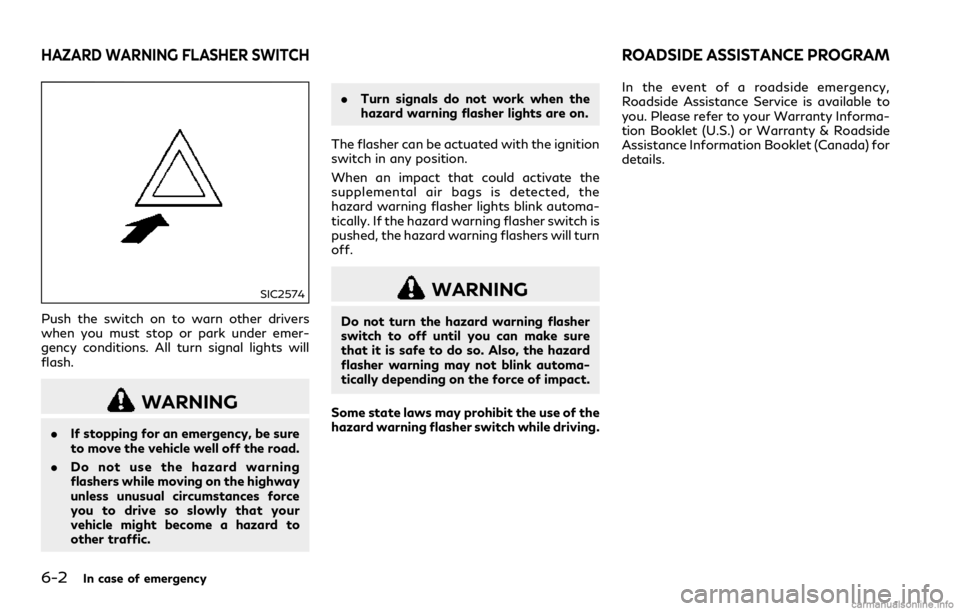
6-2In case of emergency
SIC2574
Push the switch on to warn other drivers
when you must stop or park under emer-
gency conditions. All turn signal lights will
flash.
WARNING
.If stopping for an emergency, be sure
to move the vehicle well off the road.
.Do not use the hazard warning
flashers while moving on the highway
unless unusual circumstances force
you to drive so slowly that your
vehicle might become a hazard to
other traffic..Turn signals do not work when the
hazard warning flasher lights are on.
The flasher can be actuated with the ignition
switch in any position.
When an impact that could activate the
supplemental air bags is detected, the
hazard warning flasher lights blink automa-
tically. If the hazard warning flasher switch is
pushed, the hazard warning flashers will turn
off.
WARNING
Do not turn the hazard warning flasher
switch to off until you can make sure
that it is safe to do so. Also, the hazard
flasher warning may not blink automa-
tically depending on the force of impact.
Some state laws may prohibit the use of the
hazard warning flasher switch while driving.In the event of a roadside emergency,
Roadside Assistance Service is available to
you. Please refer to your Warranty Informa-
tion Booklet (U.S.) or Warranty & Roadside
Assistance Information Booklet (Canada) for
details.
HAZARD WARNING FLASHER SWITCHROADSIDE ASSISTANCE PROGRAM
Page 328 of 466
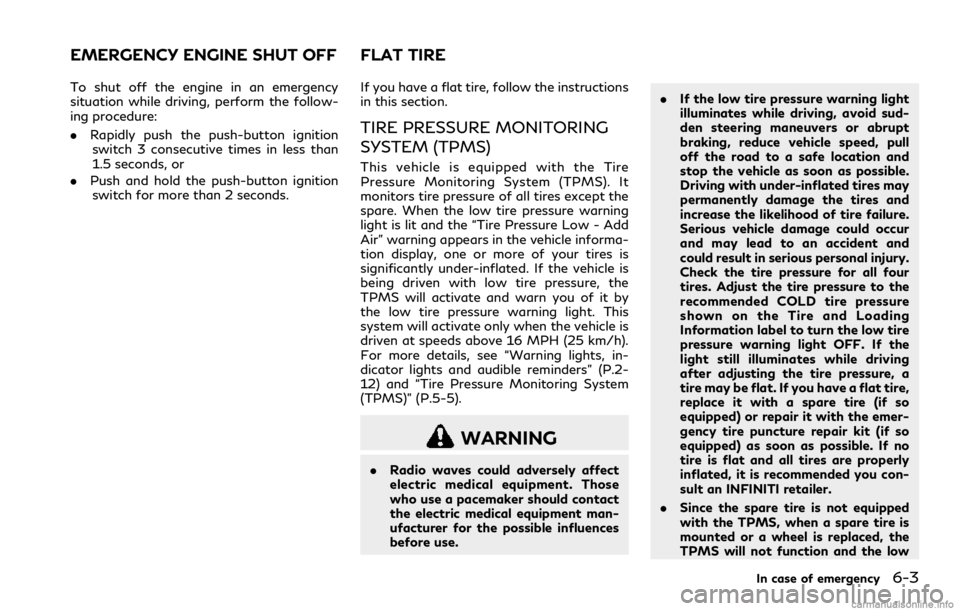
To shut off the engine in an emergency
situation while driving, perform the follow-
ing procedure:
.Rapidly push the push-button ignition
switch 3 consecutive times in less than
1.5 seconds, or
.Push and hold the push-button ignition
switch for more than 2 seconds.If you have a flat tire, follow the instructions
in this section.
TIRE PRESSURE MONITORING
SYSTEM (TPMS)
This vehicle is equipped with the Tire
Pressure Monitoring System (TPMS). It
monitors tire pressure of all tires except the
spare. When the low tire pressure warning
light is lit and the “Tire Pressure Low - Add
Air” warning appears in the vehicle informa-
tion display, one or more of your tires is
significantly under-inflated. If the vehicle is
being driven with low tire pressure, the
TPMS will activate and warn you of it by
the low tire pressure warning light. This
system will activate only when the vehicle is
driven at speeds above 16 MPH (25 km/h).
For more details, see “Warning lights, in-
dicator lights and audible reminders” (P.2-
12) and “Tire Pressure Monitoring System
(TPMS)” (P.5-5).
WARNING
.Radio waves could adversely affect
electric medical equipment. Those
who use a pacemaker should contact
the electric medical equipment man-
ufacturer for the possible influences
before use..If the low tire pressure warning light
illuminates while driving, avoid sud-
den steering maneuvers or abrupt
braking, reduce vehicle speed, pull
off the road to a safe location and
stop the vehicle as soon as possible.
Driving with under-inflated tires may
permanently damage the tires and
increase the likelihood of tire failure.
Serious vehicle damage could occur
and may lead to an accident and
could result in serious personal injury.
Check the tire pressure for all four
tires. Adjust the tire pressure to the
recommended COLD tire pressure
shown on the Tire and Loading
Information label to turn the low tire
pressure warning light OFF. If the
light still illuminates while driving
after adjusting the tire pressure, a
tire may be flat. If you have a flat tire,
replace it with a spare tire (if so
equipped) or repair it with the emer-
gency tire puncture repair kit (if so
equipped) as soon as possible. If no
tire is flat and all tires are properly
inflated, it is recommended you con-
sult an INFINITI retailer.
.Since the spare tire is not equipped
with the TPMS, when a spare tire is
mounted or a wheel is replaced, the
TPMS will not function and the low
In case of emergency6-3
EMERGENCY ENGINE SHUT OFF FLAT TIRE
Page 329 of 466

6-4In case of emergency
tire pressure warning light will flash
for approximately 1 minute. The light
will remain on after 1 minute. Have
your tires replaced and/or TPMS
system reset as soon as possible. It
is recommended you visit an INFINITI
retailer for these services.
.Replacing tires with those not origin-
ally specified by INFINITI could affect
the proper operation of the TPMS.
.Do not inject any tire liquid or aerosol
tire sealant into the tires, as this may
cause a malfunction of the tire pres-
sure sensors.
.INFINITI recommends using only
Genuine NISSAN Emergency Tire
Sealant provided with your vehicle.
Other tire sealants may damage the
valve stem seal which can cause the
tire to lose air pressure. It is recom-
mended you visit an INFINITI retailer
as soon as possible after using tire
repair sealant (for models equipped
with the emergency tire puncture
repair kit).RUN-FLAT TIRES
Run-flat tires are those tires that can be
used temporarily if they are punctured. See
“Run-flat tires” (P.8-39).
Also, refer to “Important Tire Safety Infor-
mation” (US) or “Tire Safety Information”
(Canada) in the INFINITI Warranty Informa-
tion Booklet.
WARNING
.Although you can continue driving
with a punctured run-flat tire, re-
member that vehicle handling stabi-
lity is reduced, which could lead to an
accident and personal injury. Also,
driving a long distance at high speeds
may damage the tires.
.Do not drive at speeds above 50
MPH (80 km/h) and do not drive
more than approximately 93 miles
(150 km) with a punctured run-flat
tire. The actual distance the vehicle
can be driven on a flat tire depends on
outside temperature, vehicle load,
road conditions and other factors.
.Drive safely at reduced speeds. Avoid
hard cornering or braking, which may
cause you to lose control of the
vehicle..If you detect any unusual sounds or
vibrations while driving with a punc-
tured run-flat tire, pull off the road
to a safe location and stop the vehicle
as soon as possible. The tire may be
seriously damaged and need to be
replaced.
CAUTION
.Never install tire chains on a punctu-
red run-flat tire, as this could damage
your vehicle.
.Avoid driving over any projection or
pothole, as the clearance between
the vehicle and the ground is smaller
than normal.
.Do not enter an automated car wash
with a punctured run-flat tire.
.It is recommended you have the
punctured tire inspected by an
INFINITI retailer or other authorized
repair shop. Replace the tire as soon
as possible if the tire is seriously
damaged.
Page 330 of 466
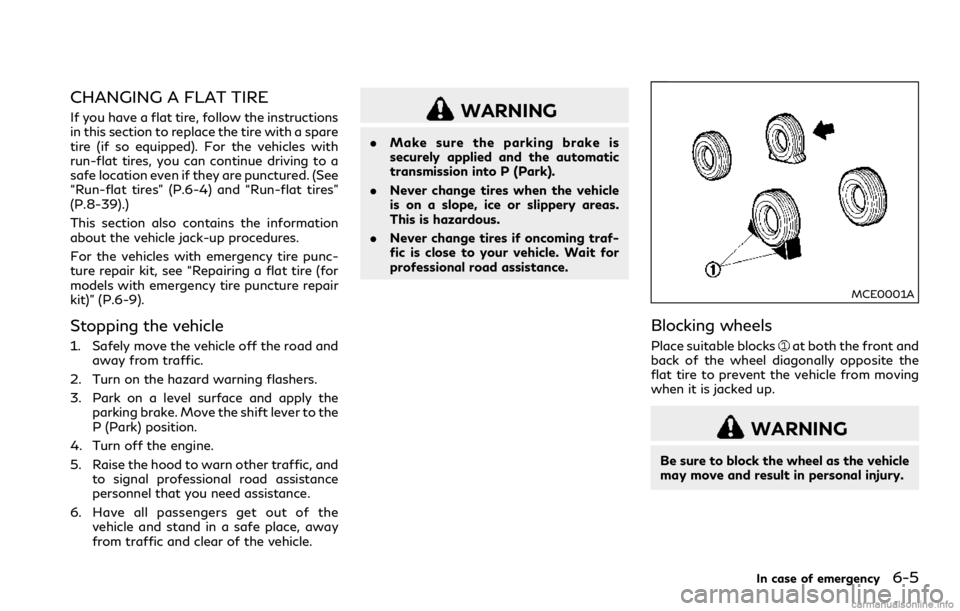
CHANGING A FLAT TIRE
If you have a flat tire, follow the instructions
in this section to replace the tire with a spare
tire (if so equipped). For the vehicles with
run-flat tires, you can continue driving to a
safe location even if they are punctured. (See
“Run-flat tires” (P.6-4) and “Run-flat tires”
(P.8-39).)
This section also contains the information
about the vehicle jack-up procedures.
For the vehicles with emergency tire punc-
ture repair kit, see “Repairing a flat tire (for
models with emergency tire puncture repair
kit)” (P.6-9).
Stopping the vehicle
1. Safely move the vehicle off the road and
away from traffic.
2. Turn on the hazard warning flashers.
3. Park on a level surface and apply the
parking brake. Move the shift lever to the
P (Park) position.
4. Turn off the engine.
5. Raise the hood to warn other traffic, and
to signal professional road assistance
personnel that you need assistance.
6. Have all passengers get out of the
vehicle and stand in a safe place, away
from traffic and clear of the vehicle.
WARNING
.Make sure the parking brake is
securely applied and the automatic
transmission into P (Park).
.Never change tires when the vehicle
is on a slope, ice or slippery areas.
This is hazardous.
.Never change tires if oncoming traf-
fic is close to your vehicle. Wait for
professional road assistance.
MCE0001A
Blocking wheels
Place suitable blocksat both the front and
back of the wheel diagonally opposite the
flat tire to prevent the vehicle from moving
when it is jacked up.
WARNING
Be sure to block the wheel as the vehicle
may move and result in personal injury.
In case of emergency6-5